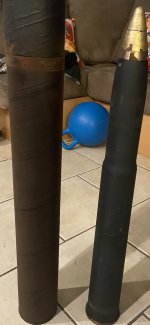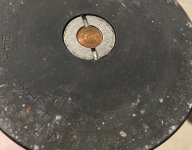I found this in an antique shop and just had to have it. It was the second one we saw that day so I felt like it was a sign. Well I don’t know much about them but I got to thinking about if it was live or not. A quick google search did t give meant info on this particular round except that the dummy rounds of these were wood. Mine is definitely steel. It sounds somewhat hollow, but there are no holes drilled into it at all and it is very heavy. The bottom has a firing cap in the center. Google tells me all about the guns it could have been used in, but nothing about the actual rounds or anything. I have googled every number on it and even some image searches and gotten nothing but mixed messages on if it’s a dummy or a live round that hasn’t been decommissioned. The place I bought it from didn’t know anything about it as they got it via a lump sell on someone’s estate after they passed. I would think it wasn’t live, but the area it came from had a very active military fort that was still in use all the way up to 1947. And still to this day, military vessels and transport go through the area quite frequently. Can anyone here give me any clues as to this being a dummy or a live round? It came in a case shown next to it. I apologize for the photo of the bottom not being of the whole thing, I had to crop it down in order to upload it. What’s seen is literally the only letters and numbers that are still visible. The case says “3 inch gun, M1902, M1919” and “M1, M3, M5, M6, M7, Container 3in, M28).
Attachments
Last edited:



